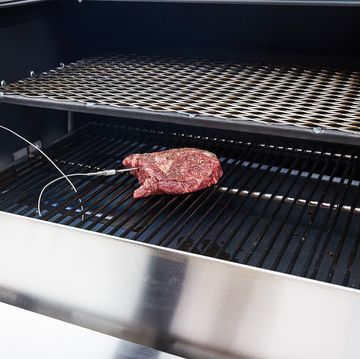One day last year, while sitting at a bar with coworkers, Scott Bush, founder of Templeton Rye, a superior spirit aged in the Iowa cornfields, had an epiphany: He should raise a batch of pigs on spent rye mash, the leftover grains from the whiskey-making process. That way, the rich flavor of the mash—and, by extension, of Templeton Rye—might find its way into the hogs' flesh. And then the pork—and the bacon!—would take on the flavor of whiskey.
Maybe it was the booze, but it sounded like genius at the time.
Scientifically, Bush's idea made sense, sort of. Just as the ham from black Iberian pigs gets its unique flavor from the acorns they eat, these pigs would get their own flavor from the mash, which in Templeton's case is made up of 90 percent rye and 10 percent barley. To create the pigs' diet, Bush recruited Mark Bertram, who holds a doctorate in the extremely specific field of swine nutrition from Iowa State University. "The process is pretty straightforward from a biological standpoint," Bertram says. "The pig is breaking down the nutrients and rebuilding them into muscle." It's the different fatty acids in the food source—here, the mash—that can change the taste.
Breed matters, too, so Bush and Bertram chose Duroc pigs, a heritage breed known for its tender, flavorful meat. This past February, 25 piglets began eating their carefully crafted diets as little 50-pound 9-week-olds. A friend of Bush's raised the reddish-brown, floppy-eared swine on a small family farm in Woodward, Iowa, feeding them 20 percent mash—the upper limit Bertram calculated they could safely consume—combined with corn and soybean meal. The hogs grew fast, doubling in weight every three to five weeks, until they were 20 weeks old and 210 pounds each.
On the last day of their lives, in early July, a heavy rain pattered on the metal roof of the pig barn, located at the end of a remote gravel road. The open pens smelled as expected, but faintly mixed in with the scent of swine and manure was the sweet, molasses-like hint of mash. "It smells wonderful," Bush says. "They seem to really enjoy it." Bertram agrees, though in slightly more scientific terms: "They're very adaptable creatures."
The pigs, available for preorder, had all been spoken for, with about half going to restaurants. The verdict: The pork didn't get you drunk or scream whiskey, but it was fantastic. "There's no way for anyone to take a bite of the pork and taste that it has 20 percent Templeton mash in the feed," says Top Chef winner Stephanie Izard, who cooked one of the pigs for a themed dinner at her Little Goat Diner, in Chicago. Still, Izard thought the pork flavorful and the fattiness perfect. "If we had made bacon, it would have been beautiful," she says. One attendee said this after Izard's dinner: "It was hands down the best-tasting pig I've ever eaten."
Considering its inaugural success, Bush doesn't discount another whiskey-pig program next year. "We're whiskey makers, not pig farmers," he says. "But it's something we'd like to continue." He's also considering two pig crops a year, one in summer and one in fall. And though there are no solid plans yet, he's even talked of expanding to chickens, turkeys, and cows. If so, the menu line writes itself: Whiskey-raised filet mignon wrapped in whiskey bacon. People would order that.
Try This: Fat Washing
• Pour 1 ounce of rendered bacon fat into a glass jar with whiskey.
• Put in freezer overnight, and then strain.
• Now you have bacon-infused whiskey.

Rachel Z. Arndt is the author of the essay collection Beyond Measure. Her writing has appeared in Quartz, The Believer, Fast Company, and elsewhere. She lives in Chicago.













